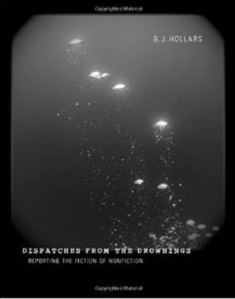Once upon a time, water leisure was a risky business in Wisconsin. A quick dip or canoe trip might result in death by drowning. Angels made by children in the riverbank snow became tombstones. Picnic? Better not. That anyone, ever, ice skated seems horrific. And so much for father/son fishing trips. Swan-diving daredevils or loggers, it could be argued, knew the risks. But who could predict death by leisurely stroll?
Yet people did die this way, as evidenced by newspaper articles published and then rediscovered by B.J. Hollars in his research.
Or rather, 75 percent of these people died this way.
Backing up a minute, Dispatches From the Drowning: Reporting the Fiction of Nonfiction, consists of short clips, each telling the story of a river tragedy that took place from 1875 to 1922. These stories are then juxtaposed with photographs from the same era. Most of these stories are published as originally printed, except for 25 percent of these stories, which Hollars totally made up. The kicker is that the fiction reads exactly like the nonfiction, and the author isn’t telling which is which. What’s more, the photographic portraits, while from the same time and place as the stories, have nothing to do with the characters. The fascinating meta-narrative that results creates a delightfully creepy sense of the uncanny.
Those familiar with the cult classic Wisconsin Death Trip by Michael Lesy will make immediate connections. Both books play with text and images, and even use the same photographer, Charles Van Schiack, who left a legacy of 30,000 glass plates made between 1890 and 1910. In many ways, Dispatches functions as a sequel. Both are, to quote Lesy from his introduction, “as much an exercise of history as an experiment of alchemy.”
Given all the mental psychosis, nervous breakdowns, and postpartum depression, the method suits the subject. Linear narrative has no place here. And the move to fabricated stories feels inevitable, given that excerpts from Wisconsin Death Trip could function as fiction workshop prompts:
“Mrs. Hiram McDonald of Eau Claire, rendered insane by religious excitement, attacked her children recently and wrecked the furniture and windows in her house.”
“Tramps are overruning Grant County, raiding sheep and stealing horses. The farmers are organizing a vigilance committee.”
“There were two black barbers in town. One was named Nichols and the other fellow was named Lyons.”
The characters’ stakes in both books are simple, life and death. No quiet stories here. The frontier was a harsh place where minor slips could yield tragic results.
From Dispatches:
“Eight year old Augustus Selbach was gathering shells on the logs near the reservoir when he lost his footing and fell into the river.”
“The river gave up its dead Friday morning, riverman Martin Nelson stumbling upon the body of William Anderson about a mile above Portersville.”
“On Monday last, laborer Ole Monson of Marinette informed his wife that he had had quite enough of her, and without fanfare, left their home to hurl himself into the Menominee River.”
All this death makes for a heavy book. Heavy in the ’70s slang sense. Heavy, man. Somewhere around clown suit as cause of death, I found myself with a case of nervous giggles. Soon after, (akin to binge watching American Horror Story), I experienced Sudden Creepout Syndrome, a condition indicated by a cat leap straight in the air followed by a frantic drawing of all the curtains.
If Jaws made you afraid of the ocean, then Dispatches will make you think twice about that rafting vacation. The book’s blurring of fact and fiction ingeniously amplifies the fear factor. At first, the idea that some of the stories aren’t real is a comfort, but this initial relief backfires, for the first question anyone has after learning of a death is, “How?” These deaths are haunted by the unknown; no one will never, ever really know what happened in those final murky moments underwater.
I’m sure there’s some enterprising soul compelled to determine which of the stories are true and which are falsehoods. I had my Sherlockian moment where I was convinced I had pegged Hollars’s distinctive use of the em dash. During this phase I thought I could order the tragedies, make sense of them—but then I began to think I was missing the point. And so I ceased to struggle, allowed the introduction to fade from memory, and let myself sink down the Chippewa River.
____
Kelly Kathleen Ferguson is the author of My Life as Laura: How I Searched for Laura Ingalls Wilder and Found Myself . Her work has appeared in New England Review, The Gettysburg Review, mental_floss magazine, and other publications. She writes and teaches in Lafayette, Louisiana.

